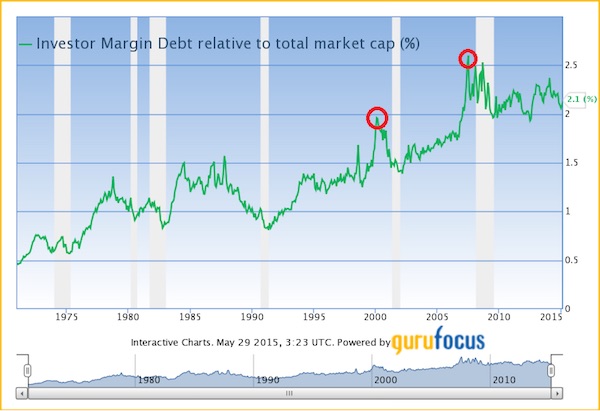This Market Indicator Suggests a Continued Bull Market
There’s not a lot of enthusiasm for trading with borrowed money, despite low interest rates. That’s a contrarian bullish sign.

The current bull market, which started in early 2009, has been called “the most hated bull market in history.” It seems investors have been waiting in vain for that other shoe to drop only to see the market march higher with nary a correction.
Stocks climb a proverbial wall of worry, and negative sentiment among rank-and-file investors is actually a contrarian bullish sign. It is when sentiment gets one-sidedly bullish and investors throw caution to the wind that you know a major top is near.
But with the S&P 500 now sitting near all-time highs… and tripling in value from its 2009 crisis lows… is it really fair to call this rally “hated”?

Sign up for Kiplinger’s Free E-Newsletters
Profit and prosper with the best of expert advice on investing, taxes, retirement, personal finance and more - straight to your e-mail.
Profit and prosper with the best of expert advice - straight to your e-mail.
Let’s take a look at investor trading on margin. When investors are feeling bullish, they are a lot more likely to trade aggressively… and to borrow money to do it.

As you can see in the chart, investor margin debt as a percentage of market cap does indeed tend to surge leading into a major market top and tends to fall dramatically during a market decline. We saw investor margin debt jump from less than 1% of market cap to nearly 2% during the great 1990s tech bubble. And it had another major spike during the bull market of the mid 2000s.
Today, we certainly don’t see a lot of investor enthusiasm for margin trading, and margin debt is actually trending lower. We’re still at levels that are high by historical standards, but much of this can be explained by two factors:
- Ease of margin trading with discount online brokers
- Falling interest rates over the past 30 years…and particularly over the past 6 years.
Remember, the Fed has kept short-term lending rates at close to zero for six years now, so it’s natural that investors will borrow more aggressively on margin. “Free money” makes carry trades that wouldn’t be profitable under “normal” conditions worth doing. Seen in this context, today’s margin debt levels are far less impressive and certainly far less indicative of investor enthusiasm.
So, at least by this metric, our bull market today really is more unloved than hated, at least by the standards of recent major tops.
Get Kiplinger Today newsletter — free
Profit and prosper with the best of Kiplinger's advice on investing, taxes, retirement, personal finance and much more. Delivered daily. Enter your email in the box and click Sign Me Up.

Charles Lewis Sizemore, CFA is the Chief Investment Officer of Sizemore Capital Management LLC, a registered investment advisor based in Dallas, Texas. Charles is a frequent guest on CNBC, Bloomberg TV and Fox Business News, has been quoted in Barron's Magazine, The Wall Street Journal, and The Washington Post and is a frequent contributor to Yahoo Finance, Forbes Moneybuilder, GuruFocus, MarketWatch and InvestorPlace.com.
-
 12 Investments No Retiree Should Make
12 Investments No Retiree Should MakeIn retirement, when it's wise to take fewer risks with your nest egg, some investments are just nuts.
By David Rodeck
-
 What the Capital One Discover Merger Means for Your Wallet
What the Capital One Discover Merger Means for Your WalletThe Capital One Discover merger reshapes the credit card landscape and could impact your credit card rewards, interest rates and card perks.
By Paige Cerulli
-
 Before You Invest Like a Politician, Consider This Dilemma
Before You Invest Like a Politician, Consider This DilemmaAs apps that track congressional stock trading become more popular, investors need to take into consideration some caveats.
By Ryan K. Snover, Investment Adviser Representative
-
 How to Put Together Your Personal Net Worth Statement
How to Put Together Your Personal Net Worth StatementNow that tax season is over for most of us, it's the perfect time to organize your assets and liabilities to assess your financial wellness.
By Denise McClain, JD, CPA
-
 Bouncing Back: New Tunes for Millennials Trying to Make It
Bouncing Back: New Tunes for Millennials Trying to Make ItAdele's mournful melodies kick off this generation's financial playlist, but with the right plan, Millennials can finish strong.
By Alvina Lo
-
 Early-Stage Startup Deals: How Do Convertible Notes Work?
Early-Stage Startup Deals: How Do Convertible Notes Work?Some angel investors support early startups by providing a loan in exchange for a convertible note, which includes annual interest and a maturity date.
By Murat Abdrakhmanov
-
 SRI Redefined: Going Beyond Socially Responsible Investing
SRI Redefined: Going Beyond Socially Responsible InvestingNow that climate change has progressed to a changed climate, sustainable investing needs to evolve to address new demands of resilience and innovation.
By Peter Krull, CSRIC®
-
 Here's When a Lack of Credit Card Debt Can Cause You Problems
Here's When a Lack of Credit Card Debt Can Cause You ProblemsUsually, getting a new credit card can be difficult if you have too much card debt, but this bank customer ran into an issue because he had no debt at all.
By H. Dennis Beaver, Esq.
-
 Going to College? How to Navigate the Financial Planning
Going to College? How to Navigate the Financial PlanningCollege decisions this year seem even more complex than usual, including determining whether a school is a 'financial fit.' Here's how to find your way.
By Chris Ebeling
-
 Financial Steps After a Loved One's Alzheimer's Diagnosis
Financial Steps After a Loved One's Alzheimer's DiagnosisIt's important to move fast on legal safeguards, estate planning and more while your loved one still has the capacity to make decisions.
By Thomas C. West, CLU®, ChFC®, AIF®